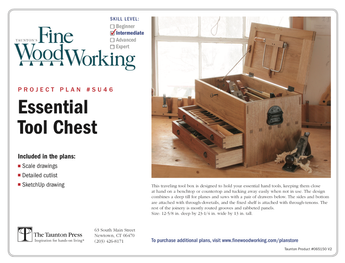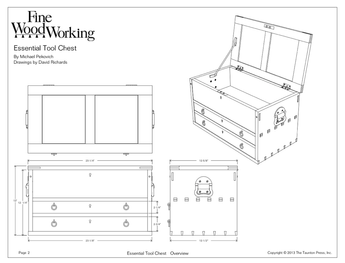When using hot hide glue vs a glue like titebond, what do you do differently with the squeeze out from the joint? I’ve heard/read that hide glue takes stains or dyes more readily than a titebond type glue but the best alternative is to eliminate the glue in the first place. Do you wipe it with a warm damp rag, let it harden and remove it with a chisel? Do glue spots show up when working with an open pore wood like mahogany.















Replies
Hot hide glue will gel to a rubber like consistency and can be peeled off quite easily. Letting it fully cure is not a good idea, as it becomes very brittle and tends to take loose wood fibers with it, especially from open grain woods. You can also safely wipe it off with a damp rag; this is in effect what is done every time with hammer veneering. I've not had any problems with the glue getting in the open grain of mahogany and interfering with the finish. I did have one problem with hide glue showing up under the finish, when using my standard Lime/Water finish, but that was because I left a somewhat large glob of glue on the surface ( poor surface preparation on my part, but the problem was easily fixed).
Hot hide glue is hands down my favorite glue.
Rob Millard
http://www.americanfederalperiod.com
I've found a couple instances where I thought hide glue that I smeared (carefully wiped is really the wrong word in my case) into the grain disturbed an oil finish. I try to remove hide glue when it gels. If you get it at the right time, it will come off cleanly. But it can be a little like silicone caulk. If you wait too long, you might pull the rubbery glue clean out of a gappy joint. So what I've been doing is jabbing at it with my striking knife to see if its gelled- when it has gelled, I try to slice it with the knife end of my striking knife and this has work.
Be careful chiselling dry hide glue. It can be quite brittle and I've had pieces fly up and hit my eye glasses. PVA sure doesn't do that.
And I have a question for Rob: When you first apply it and you get some runs- do you wipe them then or wait until they gell and slice/peel them off? Also- do you slow your glue down? Have you done any large edge joints for example? Last one I tried it took too long with clamps, and glue gelled and I had a black vinyl record (remember those?) between my boards when I was done. I'm guessing you've mastered the large glue up?
BTW, I think that would be an interesting magazine article. I always say how easy hide glue is to use, but I think that there are also a lot of little technques that guys like you and Pat Edwards use that I know I'd be interested to know more about.
Adam
Adam, next time you get squeezeout with hot hide glue that you missed, reheat the area with a heatgun, the glue will soften and you can peel it off with a putty knife.
mike
Do you have nay idea how difficult it is to use a "period" heatgun?
Hehehe.My goal is for my work to outlast me. Expect my joinery to get simpler as time goes by.
Especially by yourself..... no one to operate the bellows.
Since the house is on fire let us warm ourselves. ~Italian Proverb
You've convinced me to give this a try. I guess it's off to the Old Mill Cabinet Shoppe to pick up a glue pot and materials. Thanks for your input!
Don't buy the dedicated glue pot--around $100--get a Crock Pot or equivalent for $15 or so at any of the discount stores. Use it as a water bath for glue mixed in a Mason jar. Temperature on mine keeps the glue at 140°--generally considered ideal.
I use a 1 litre crockpot for the hide glue . But I did put a lamp dimmer switch in the cable, filed it up with water, made a mark on the switch at 40 and 60 deg ( or the manufactures specification ) and then you can fill your pot with the glue. saves on water spills and you can take the pot to where the gluing is done .
I use this method already for the last 15 years in my chair making workshop.
Before the hide glue I did try all sorts of glue and they all have advantages.
The best thing I found was that the clamping takes only half to one Hour for the chair frame etc.
But the best thing I found is that when it goes wrong heat up the joint (with heat gun) and reset it and one hour later your on track again.
Cheerio have a nice time.
Steve and everybody,I really like using a traditional cast iron glue pot and boiler. I use a cheap electric burner to heat it. I think the cast iron regulates the heat well and it allows me to take the hot pot to the job. Its also easy to clean. I wouldn't pay more than $20 for the cast iron pot second hand. I see these regularly at flea markets and antique shops with "country flowers" in them or some such labeled "rustic pot pourri". Just make sure the pots both hold water and aren't thin from rust.Adam
I don't suppose the iron has any impact on coloration of the glue--and except when veneering the glue won't be visible anyway. I'd call it a nearly pure aesthetic decision. I don't think my wife would let me put the iron pot in the refridgerator--wide mouth mason jars are a lot easier to slip by.
Right. The inner pot gets rusty. I wouldn't want it in my refrigerator. The top gets covered with glue drips and generally nasty. You could seal it with plastic wrap I guess. I never have.You could pour the left over glue into something else for cold storage. I don't. Hide glue lasts in my shop for over a week which suits me fine. So in terms of storage, I don't think the iron glue pot is all that great. The only advantage that I see is the convenience of being able to take the glue to the job. My experience with glass jars is that once removed from the water you only have a few minutes of working time. The cast iron pot probably doubles that. You might get a good five or more minutes (based on the temp of your shop).
Adam,
I wait until the runs or squeeze out gels and then just peel it off.
I do add urea to the glue for complicated glue ups. For edge joints if they are say 2' and under I just use the glue without additives. I plane the joints so it is a perfect fit (in other words no spring ) and treat it like a large rub joint. For longer joints I do the same thing, but I do add some urea. I've never glued anything longer than 4'. I use to use liquid hide glue for some things, but I've gotten away from it, due to its short shelf life. The only time I think I'd use it again would be for assembling a sideboard, which are very difficult to glue up in a hurry. The liquid hide glue put out by Pat Edwards is the best I've used, for complicated glue ups.
I think hide glue would a good subject for an article. There seems to be quite a bit of interest in it.
Rob Millard
As with most problems an ounce of prevention.......
With all glues try using auto masking tape to border the joints. Parafilm"M" from American Can Company is good for large areas, it's used in labs to protect benchtops.
This forum post is now archived. Commenting has been disabled